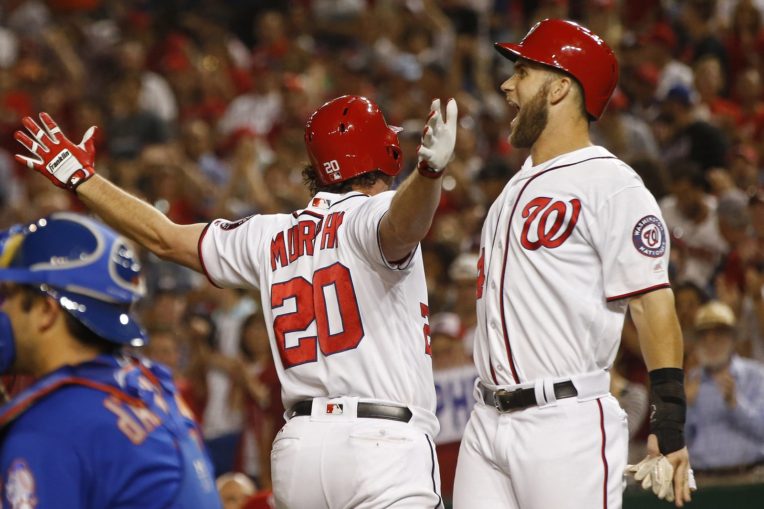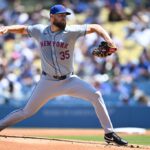
There is so much to write about when it comes to the Mets that we often forget there are things happening outside of New York that we should discuss. While we as Mets fans have become accustomed to underperformance and falling short of expectations, there is another team in our division with high hopes entering 2018 that, to say the least, have missed their mark.
Going into this season, it was widely assumed that the NL East would finish with the Nationals in first place and the Mets on their tail in second. However, one week from the non-waiver trade deadline (July 31), the standings are scrambled. It’s not the Nationals and Mets atop the standings, it’s the Braves (54-43) and the Phillies (55-44). The Nationals are in third place, six games back, with a 49-50 record, while the Mets (40-57) are in last place behind the Marlins (43-59).
The Phillies and Braves are buyers this July, and both have a strong lead over the Nationals. Further, they both have plenty of money to spend, as well as strong farm systems to bring in the Major League talent necessary to improve their squad. The Nationals, on the other hand, are not in as prime a situation.
The Nats are not only six games out of first place in the NL East, but they’re in eighth place in the NL Wild Card race. The Brewers, who beat the Nats Monday night, top the list with a 57-45 record. Following them are the Phillies, Diamondbacks (55-46), Rockies (53-46), Pirates (52-49), Giants (51-50), Cardinals (50-50), and then the Nationals. To put it in perspective, the only teams in the National League with worse records than the Nats are the Reds (44-56), Marlins (43-59), Mets (40-57), and Padres (42-61).
Jon Paul Morosi of MLB.com reports that the Nationals are pursuing Rangers starting pitcher Cole Hamels. Morosi points out that the Mariners, Braves, and Yankees have also shown interest in the lefty. Those are all teams that need starting pitching help more than the Nats and have better pieces to acquire him. So, instead of out-bidding those other teams and over-paying for an aging starter just to miss the playoffs, they should sell.
Yes, the Nats could still make the playoffs. But considering most if not all of those other teams will be improving at the deadline, it would be quite the uphill battle. Even then, they would still need to jump that pesky “win a playoff series” hurtle they have yet to clear. The smart thing to do would be to sell their impending free agents, as there are plenty of them, and save money for the crazy free agent class coming this offseason. Let’s take inventory.

It goes without saying, but the 2015 NL MVP would command a king’s ransom on the market. Yes, he is having a down year (but not as bad as you think). The alternative would be letting him go to free agency and securing either a late first round pick or a supplemental first round pick in the 2019 draft. With certainty I can say that the Nationals would bring back more value in a trade with a team looking for an impact bat than that one draft pick.
Harper is hitting .216/.365/.470 this season with 24 home runs and 59 RBIs. When diagnosing the issue that may have caused his low batting average, you may point to the raised strikeout rate of 25.1 percent, up from 20 percent in 2015, 18.7 percent in 2016, and 20.1 percent in 2017. The rest of his rates are right on with his career marks, including his line drive rate (21.4 percent), ground ball rate (39.3 percent), and fly ball rate (39.3 percent). In fact, his infield fly ball (pop up) rate is by far the lowest of his career at 3.3 percent.
So… What is it? He’s hitting just as many ground balls, line drives, and fly balls as ever. Sure he’s striking out a bit more, but that doesn’t explain the crater of a batting average he currently has. The reason for that could be as simple as this: Bad luck.
Harper’s career BABIP, or batting average on balls in play, sits at .314 — fairly average. His BABIP for this season, however, is .230. As we know he’s hitting the ball as he always has, bad luck is a fair diagnosis for his under performance. He still has the power as his 24 home runs can attest (he’s on pace for 38), and looking at the metrics, he’s a prime breakout candidate for the second half of 2018.
Any team doing minimal research will find the same numbers I did. Further, it’s just a known fact that Harper is really good at baseball. If the Nationals choose to sell, they should follow the Orioles’ lead and trade their best hitter, instead of letting him walk via free agency, settling for a draft pick.
Harper joins Daniel Murphy, Gio Gonzalez, Matt Wieters, Kelvin Herrera, Ryan Madson, Shawn Kelley, Matt Adams, Jeremy Hellickson and Mark Reynolds who are all due to be free agents this offseason. With the exception of Harper and possibly Herrera, none of those players are sure to factor in to the Nationals future plans.
The safest and smartest course of action would be to sell all those guys and bring in a ton of young talent, close enough to MLB-ready to help out in 2019 or 2020. When talking about all this, though, it’s important to keep in mind who the Nationals would be keeping; those who are not going to be free agents at the end of this season.
Max Scherzer, Stephen Strasburg, Tanner Roark, Brandon Kintzler, Anthony Rendon, Trea Turner, Ryan Zimmerman, Juan Soto, Michael A. Taylor and Adam Eaton are all under team control for next season and beyond. There is a lot of money invested in those players, and they’re a very solid core to build around to say the least.
Sell all the impending free agents, save a ton of money, and stock for the future. If money is saved this summer, that could give them more to spend in the crowded free agent class this offseason. The Phillies and Braves are going to be good for a long time, and if the Nationals don’t sell now, they could miss their window to compete right along side them.















